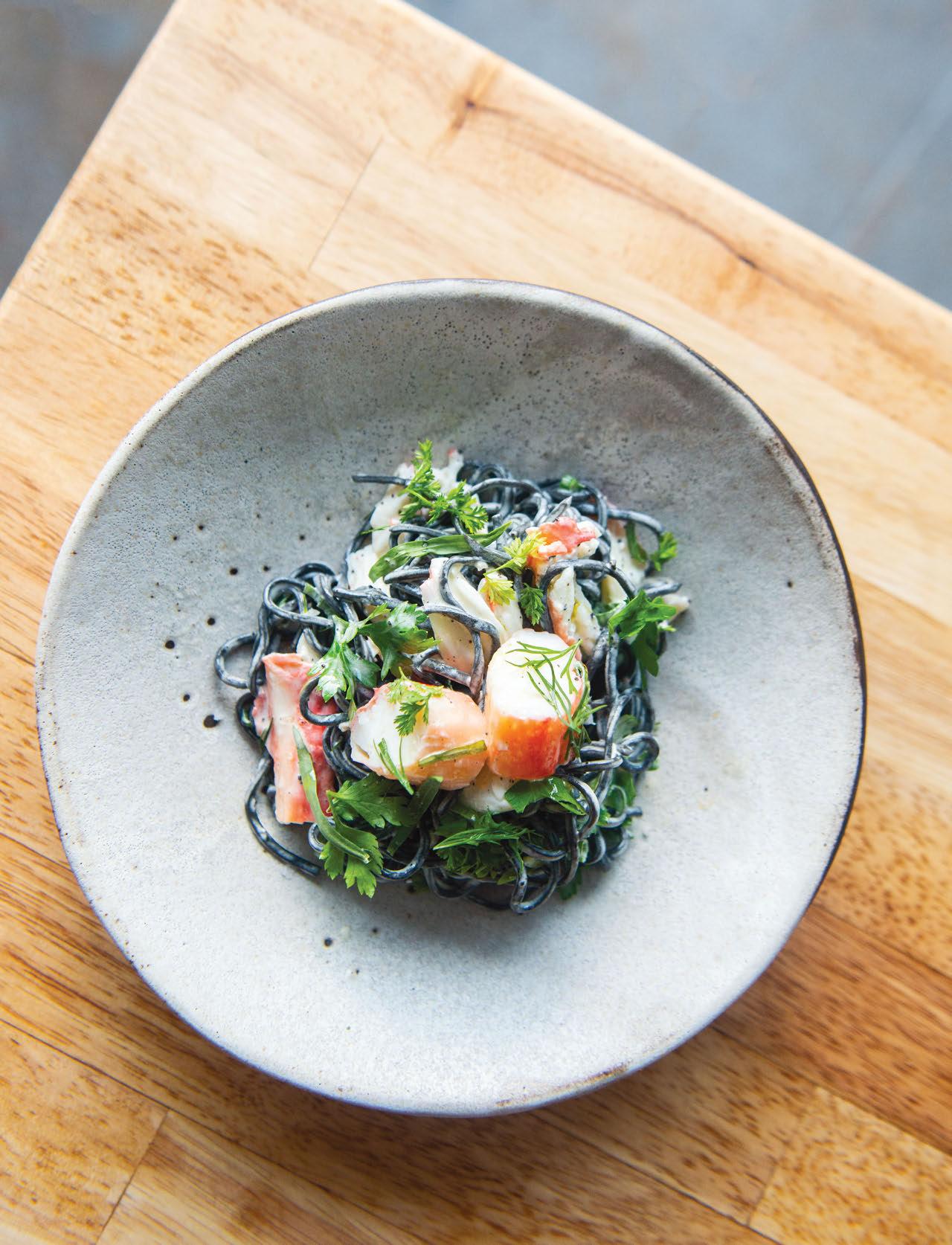
11 minute read
LUCIANA GIANGRANDI ALEX MEYER
BLUNT WILL PHOTO:
Luciana Giangrandi and Alex Meyer
Advertisement
BOIA DE
Luciana Giangrandi and Alex Meyer had to jump through a few hoops before they nally met. In 2008, Giangrandi completed a non- ction writing degree at e New School while Meyer studied economics at Emory University. An aspiring food writer, she interned at Scarpetta and ended up staying for three years. Meanwhile in Los Angeles, he worked under Rising Stars alumni Jon Shook and Vinny Dotolo at Animal and helped them open Son of a Gun. With a move to New York, Meyer staged at Eleven Madison Park before being hired full-time.
e couple’s paths crossed as part of the opening team of Daniel Humm and Will Guidara’s e NoMad Restaurant in 2012. Within a year, Meyer became sous chef, and Giangrandi moved on to Carbone. She visited Italy to spend a summer cooking in Tuscany, and Meyer quit his job and followed. e partners traveled to Mexico and Japan, consulted and catered in Meyer’s native Los Angeles, and settled in Giangrandi’s hometown of Miami.
By 2018, she and Meyer were drawing attention with the launch of their Design District taco cart, La Pollita. Despite a loyal following, they closed down in 2019 but opened Boia De (Italian for “Oh my!”) a month later. With their combined chops, the Italian restaurant was named Eater Miami’s Best Restaurant in 2019. stinkyfishtales / akmeyer4 / boiaderestaurant
Luciana
Favorite kitchen tool: My Takamura chef knife and a cake tester Favorite cookbook: I’ve had a copy of Il Talismano della Felicità for as long as I can remember. My mom had a copy in our kitchen, and although it's not meant for professional cooks, it’s a great reference of Italian cuisine.
Where you eat on your
nights o : I really like eating and drinking the complete opposite of what we o er at the restaurant—I like going out for cocktails and steak at Jaguar Sun, sake and sushi at one of the great omakase experiences around town, or anything from Lil’ Laos.
Advice to your younger self:
Be patient, put your head down, work hard, and absorb all you can from the talented people you come across in your career, and never leave a job on bad terms.
Alex
Favorite kitchen tool: Powderfree latex gloves. I never really thought of them in those terms until the great latex glove shortage of 2020-2021. ey’ve been almost impossible to nd, and like Joni Mitchell said, “You don’t know what you’ve got ’til it’s gone.”
Tool you wish you had:
ermoMix Favorite food resource: Harold McGee’s On Food and Cooking. It’s pure, concentrated knowledge.
Most important kitchen rule:
Taste everything.
Place to visit for culinary travel:
I’d love to go back to Japan and explore more of the regional cuisines.
Advice to your younger self:
ere are too many loud, obnoxious, and arrogant cooks out there who can’t back up their talk, so I say, “Stay humble and shut up.”

Tagliolini al nero, king crab, vin jaune
Chefs Luciana Giangrandi and Alex Meyer of Boia De Adapted by StarChefs Yield: 8 servings
INGREDIENTS
Dressing:
1 cup Kewpie mayonnaise 4 teaspoons lemon juice 2 tablespoons black tru e paste 2½ tablespoons vin jaune
Tagliolini al Nero:
1¼ cups all-purpose our 10 egg yolks 1 tablespoon squid ink Salt Olive oil
To Assemble and Serve:
Yield: 1 serving ¼ cup cleaned king crab 2 teaspoons sliced scallions, plus more to garnish Good-quality olive oil 3 pinches of equal parts parsley, tarragon, dill, chervil, and chive batons Fresh Origins micro chervil Fresh Origins micro parsley curled METHOD
For the Dressing:
Add all ingredients to a mixing bowl and stir to combine.
For the Tagliolini al Nero:
To a stand mixer t with a paddle attachment, add our. While running on medium speed, in 3 separate batches, gradually incorporate yolks and squid ink until dough is formed. Transfer dough to a clean work surface and knead 8 to 10 minutes, adding our and water as needed, until dough springs back when you press a nger into it. Let dough rest 30 minutes. Using a rolling pin, atten the dough enough to pass through the widest setting on your pasta roller. Pass the dough through the roller, once at each setting, until your sheet is 1/16 inch thick. Cut 9-inch-long sheets and run them through the tagliolini or spaghetti cutter of your pasta roller.
Blanch the pasta in salted water for 1½ minutes, then shock in ice water. Transfer noodles to a bowl and toss with olive oil to prevent sticking.
To Assemble and Serve:
Toss ¾ cup Tagliolini al Nero with crab, scallions, and enough Dressing to coat, about ¼ cup. Transfer to a serving plate and top with a drizzle of olive oil, herbs, and more scallions.
Featured ingredients: Fresh Origins microgreens




Chef Bobby Frank called together the kitchen staff of his seafood restaurant, Mignonette Mignonette, last July. You know those lobster rolls we do that everyone loves? You know the charred octopus, the lobster deviled eggs, the clams casino? Yeah, we’re eighty-sixing all of that, he told them. The idea, he explained to the staff: “Lobster tails really don’t travel well, but chicken parm does.” So they set out to deplete perishable supplies before switching over the entire menu. Ordering strategically and running lean, Mignonette then converted to a pop-up they called Red Sauce, full of Italian classics that would travel and reheat well in the days of the lockdown.
“What we realized is that during this time, people want to feel comfortable, and Italian is homey,” Frank says. “We realized they don’t want fancy for home delivery; they want a sense of being safe.” It was like that at a lot of places around Miami last year. The county ordered some form of restaurant closures twice in 2020, and suddenly, many of the city’s favorite sit-down spots converted to groceries or revamped menus when chefs realized the well-composed dishes that usually kill it in the dining room just don’t look the same in Styrofoam.
At beloved Brickell pizza place Stanzione 87 87, a collab with Chef Aaron Brooks became a pop-up offering pide, a stuffed Turkish fl atbread. South Beach taco spot Taquiza from Rising Stars alum Steve Santana hosted Naan as an Indian pop-up. At Boia De De, Rising Star Chefs Luciana Giangrandi and Alex Meyer stopped doing takeout except for a Sandwich Sundays promo. Downtown favorite Fooq’s invited Lil’ Laos in, and Zak the Baker Baker, another Rising Star alum, added evening falafel pop-ups.
At his Cuban diner, Chug’s Chug’s, Rising Star Chef Michael Beltran began selling grocery items that were in short supply at the beginning of quarantine, and Pastry Chef Devin Braddock baked loaves of bread when those disappeared from store shelves. Last summer, when Beltran began offering a midweek tasting menu at sister restaurant Ariete Ariete, trying out entirely new recipes and offering themes around exotic ingredients, the tickets would sell out within hours. “Pivoting, albeit mentally exhausting, was really what let us survive,” Beltran says. “We really learned about the job and life in general.”
At the end of August, after a brutally hot summer of outdoor dining, the county allowed restaurants to reopen dining rooms. But the ownership and management of South Beach favorite Macchialina decided against it, instead negotiating with the landlord to take over an extra outdoor area out back. Chef de Cuisine John Kreidich says people wait an hour or more for a seat. While they were doing 150 to 200 covers before the lockdown, Kreidich says that the bigger outdoor area and a strong takeout business, featuring tons of specials like Baby Back Rib Friday and Risotto Wednesday, have allowed them to do even more.
“It’s a hustle. Everything is a hustle,” Kreidich says. “We have to be constantly thinking of something new. We have the regulars, but still we have to keep bringing in people with fresh ideas.”
At Mignonette, the menu switched back to its seafood focus when the city allowed indoor dining to return. The pop-up was fun, but Frank says it felt good getting back to the core business. “We’re fortunate that we have a big local following and see a lot of the same faces,” Frank says. “When we opened again after Red Sauce, people were clapping when they came through the door because they were so excited to see us.”
❋ ❋ ❋ ❋ ❋ ❋ ❋ ❋ ❋ HOW ARE YOU HANGING ON?
The coronavirus hit Miami’s hospitality industry differently than it did other cities. Tourism took a hit, and the diffi cult season was summer, not winter, because locals didn’t want to sit in the blazing heat. We asked the community about the changes.
“I feel like the role of the somm will change. It should always be more than selling wine. We are there to assist in all areas: clearing, running, etc. I think that crossover will happen in smaller restaurants where that is already partly the case."
→ Sommelier Jen Schmitt, Zuma
“Having to lay off my staff was the hardest thing I've ever done in my career. I was calling them, hosting dinners. We were able to gobble up toilet paper and fruit and give them to staff, letting them know that they weren’t just a number in the system.”
→ Chef Daniel Roy, Ruby Dee’s
“We were predominantly wholesale, but all the hotels shut down, so that was 90 percent of our business gone. It ramped back up just as quickly, but people also wanted to sit on the couch and eat ice cream. We started sending our clients pints, which actually was a great way to get brand recognition that we hadn't had before.”
→ Ice Cream Maker Alissa Frice, Frice Cream


By Aiman Javed llustrated by Jaclyn Warren
When Sakhone Sayarath misses home, she makes khao poon gai (shredded chicken noodle soup) like her mom’s. If the nostalgia is strong, she’ll also make sai krog muu (fermented rice and pork sausage) like her dad’s. At Lil’ Laos, a food stall by Sayarath and her life partner, Chef Curtis Rhodes, the street-food-style Laotian menu has both.
Until she turned eight, Sayarath lived in a refugee camp in Thailand, where resources were limited. But she has always cooked with her parents. “These are the foods that we were forced to eat and make and create ourselves,” she says.
When she met Rhodes in Miami, he was a sous chef at The
Oceanaire Seafood Room. “He made cooking seem so simple,” she says. From friends to partners, they were always tastetesting each other’s cooking. As a professional chef, he journeyed into her food culture on dinners with her family. At home, she whipped up soups every day, and he helped her explore new cuisines.
What began as a pop-up in 2016 became a full-time venture during the pandemic. Sayarath took charge of soups and sauces at Lil’ Laos, while Rhodes was responsible for meat. “She gave me the foundation [for Laotian food],” he says.
Sayarath envisioned educating the public about the food’s origins as the fl avors came together. “It is a blend of community, memories, and family,” she says. Lil’ Laos embraces eating in a family-style setting with your hands and letting nothing go to waste.










The sai krog muu on the Lil’ Laos menu is inspired by Sayarath’s father’s recipe, who would stuff sausages using a soda bottle and grill them outside. Her sausages missed the mark, so Rhodes used his own techniques with Sayarath’s palate guiding the taste. Their creative collaboration resulted in the salty, bold, and spicy fl avors true to Laotian cuisine and refl ective of a zero-waste ethos. “There's a common interest that we both have, which is to make good, simple, delicious food that people will love,” says Sayarath. Here’s the process behind the two main elements of their sausage: fermented rice and pork (full recipe on page 83).

First, the sweet sticky rice is soaked for up to three days to ferment. For the sausage, Rhodes originally used pork belly for its fat content but then realized he could also grind in the leftover fat he had from the pork shoulders or fatback. Then, the ground pork is mixed with dill, cilantro, scallions, bird's eye chiles, garlic, shallots, makrut lime leaves, galanga, and fi sh sauce. After grinding a few more times, he adds the drained fermented rice, a binder that provides even more texture.
Finally, he stuffs the mixture into a casing to create a sausage full of fermented fl avor. Lightly pan-seared, it’s fi nished in the oven at 525°F and served on a bed of shredded cabbage with a tamarind-chile sauce.














